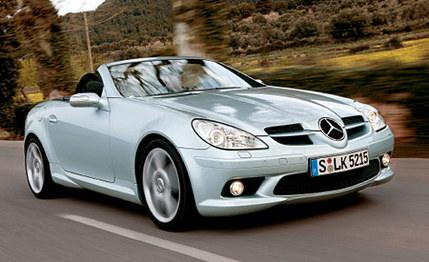 First Drive Review
First Drive Review
Upright and uptight Mercedes-Benz swung low in 1997 with a midget sports roadster priced to sell. It did, hooking 308,000 customers in seven years, an amount with which Mercedes is delighted. The SLK wasn't popular on this playground, however, where it was considered a chunky boulevard rambler. Corner crushers such as the Honda S2000 and Porsche Boxster mopped the switchbacks with the little Benz. Later, the SLK chased serious drivers with stronger engines and a six-ratio shifter for North America, but wannabe Häkkinens maintained a discreet distance.
"We recognize that the market has definitely taken a turn toward performance," says Udo Weist, senior manager of the SL and SLK product group. His title acronyms mean sportlich, leicht, and kompakt—sporty, light, compact. The first SLK was kompakt all right, and the metal-roof SLK320 carried only 170 more pounds than a canvas-top Boxster. What the SLK really needed was a more sportlich engine, suspension, steering, brakes, interior, and body.
Hello! That is precisely what Mercedes delivers with the new SLK350 and SLK55 AMG, set to hit showrooms this September.
Wind-tunnel speeds were cranked up during the shaping of the new SLK. The old car's upright face has been swept back, the headlights blasted into teardrops, and the hoodline shaved lower to the front wheels. The SLK is a real wedge now, a ringer for the Honda S2000 in some profiles. A Formula 1 tribute is etched in the protruding nose and grille wings. The propeller-sized Mercedes star pays lavish tribute to, well, Mercedes.
All this stylistic sharpening hides the SLK's expanding dimensions. Compared with the old car, there are an extra 1.2 inches in the wheelbase and another 2.8 inches separating the license plates. It's wider, too, by 2.9 inches, and taller (by an inch or so) and has a wider track.
Lovers of leicht can look elsewhere. By the company numbers, the SLK V-6 also puts on about 100 pounds, to 3250 fitted with a six-speed manual. A heavier metal top, patterned after the SL's, somersaults the rear glass during the 22-second drop for more compact stacking. Hence, trunk space with the top stowed almost doubles to seven cubic feet.
Fortunately, the SLK lays on horsepower as well. Mercedes sends the U.S. two flavors from its freezer, a new 268-hp DOHC 24-valve 3.5-liter V-6 for the SLK350, and the mighty 355-hp SOHC 24-valve 5.4-liter V-8 for the SLK55 AMG. The V-8 already does its locomotive impersonation in the CLK55 and G55, among others.
The V-6 is new, the first engine of many to come that will shred the current Mercedes rulebook. The company has been in the single-cam, three-valve, twin-spark business for more than a decade, having produced V-6s, V-8s, and V-12s off the same basic engine template. Then, the design was said to be better for emissions and fuel economy, especially when paired with the company's cylinder-deactivation system.
Now "the customer wants power, so that is why we changed to four valves," says Kay Dietzel, combustion development director for Mercedes gasoline engines. Both the three-valve head and the cylinder-deactivation system will be ditched for good when the redesigned S-class appears in 2005.
The 3.5's starting point was the old 90-degree 3.2-liter V-6 block. The new engine shares its bore centers but not its bore, adding 3.0 millimeters (to 92.9), and 2.0 millimeters to the stroke (to 86.0). The compression ratio also rises, from 10.0:1 to 10.7. A dual-length intake plenum strategizes the breathing, and variable-valve-timing adjusters on all four cams contribute to a table-top torque curve. The 258 pound-feet pull from 2400 rpm through to 5000 rpm.
Grams were trimmed off the reciprocating components, millimeters shaved by using helical gears instead of dedicated chains to drive the exhaust cams. Is Mercedes learning how to build sports-car engines? "It's not that we just learned these things, it's that we did them," says Dietzel.
In a drive through the mountains of Majorca, the SLK350 with a six-speed manual (the bigger SL's new seven-speed automatic is also optional on the SLK) spun its rear rubber willingly, the new engine blipping and blatting with a Honda's hair-trigger throttle response and cyclone-smooth spins up to its 6500-rpm redline.
There's more sportlich in the chassis, too. The recirculating-ball steering is no longer shared with heavy trucks and Maybachs, the new SLK's wheel turning a quick and friction-free rack-and-pinion. Mercedes skimmed pennies by replacing the old front unequal-length control arms with struts, but some of BMW's strut-tuning genius found its way over to Stuttgart. The SLK now darts from corner to corner with prompt and precise responses, taming its mass with clipped body roll and reliably firm brakes. Sadly, the SLK55 AMG on hand was show only, reserved for a later introduction.
Mercedes promised the world a new sports car in 1997. Deliveries are set to begin this year.